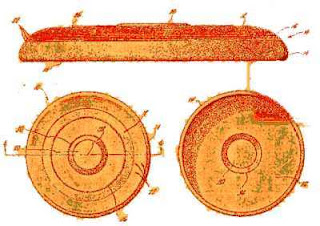 Think of the ultimate frisbee field as an art museum - plenty of frisbellipses! Thx to Russ for the tip.
Think of the ultimate frisbee field as an art museum - plenty of frisbellipses! Thx to Russ for the tip.The Frisbee of Art [NYT 9.23.10]
...The ellipse is the Frisbee of art, the circle freed from its flatness that sails out into imagined space tilting this way and that and ending up on the top of the soup bowl and silver cup in Jean-Baptiste Chardin’s still life or, imagine this, on the wheels of the speeding Batmobile.
Once you tune into ellipses, you will begin to see them everywhere: in art, as in the Chardin painting, or in life, in your morning coffee cup or the table top on which the cup sits. The ellipse is also implicit in every cylindrical form whether or not we see its end exposed (as it would be in a can or a cup or a length of pipe). Just look at the Picasso “Mother and Child.” Highlighting the ellipses helps you to understand the basic roundness of those limbs, encouraging you to see and to draw with a volumetric rather than a flat perception of what you are observing. So the ellipse is important because it exists in so many places as an actual shape, and because it is “buried” in so many round forms that we are likely to draw.
The challenge of drawing an ellipse is that it must be done with enough speed to engage the natural “roundingness” of your reflexes. In essence, you are deciding to make a particular shaped ellipse and then letting your hand and wrist move autonomously to accomplish the job. Much of what you are practicing in learning to draw is engaging your fine motor skills in this way, so that the hand moves to do your bidding without a ”controlling” space between deciding to make a particular line and the hand moving to do it. Before this kind of almost simultaneous cooperation between your brain and your hand occurs, you will tend to worry the line out in slow incremental steps. In this hand-eye coordination, drawing is an athletic activity that benefits from practice, like golf or tennis. On a page of your drawing pad, make various kinds of ellipses as a warmup for the exercise below. Keep the movement of your hand fluid and relatively fast.
...The ellipse is the Frisbee of art, the circle freed from its flatness that sails out into imagined space tilting this way and that and ending up on the top of the soup bowl and silver cup in Jean-Baptiste Chardin’s still life or, imagine this, on the wheels of the speeding Batmobile.
Once you tune into ellipses, you will begin to see them everywhere: in art, as in the Chardin painting, or in life, in your morning coffee cup or the table top on which the cup sits. The ellipse is also implicit in every cylindrical form whether or not we see its end exposed (as it would be in a can or a cup or a length of pipe). Just look at the Picasso “Mother and Child.” Highlighting the ellipses helps you to understand the basic roundness of those limbs, encouraging you to see and to draw with a volumetric rather than a flat perception of what you are observing. So the ellipse is important because it exists in so many places as an actual shape, and because it is “buried” in so many round forms that we are likely to draw.
The challenge of drawing an ellipse is that it must be done with enough speed to engage the natural “roundingness” of your reflexes. In essence, you are deciding to make a particular shaped ellipse and then letting your hand and wrist move autonomously to accomplish the job. Much of what you are practicing in learning to draw is engaging your fine motor skills in this way, so that the hand moves to do your bidding without a ”controlling” space between deciding to make a particular line and the hand moving to do it. Before this kind of almost simultaneous cooperation between your brain and your hand occurs, you will tend to worry the line out in slow incremental steps. In this hand-eye coordination, drawing is an athletic activity that benefits from practice, like golf or tennis. On a page of your drawing pad, make various kinds of ellipses as a warmup for the exercise below. Keep the movement of your hand fluid and relatively fast.
No comments:
Post a Comment